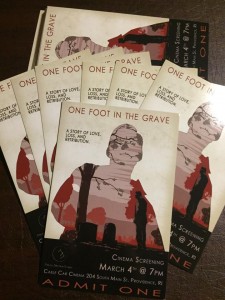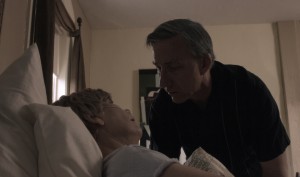 Dave Borges recently debuted his new film, One Foot in the Grave, at Cable Car Cinema in Providence. It was shown to a sizable audience of mostly cast and crew, and it was paired with Bryan Casey’s shorter thriller He Never Said a Word, a film that Borges helped to edit.
Dave Borges recently debuted his new film, One Foot in the Grave, at Cable Car Cinema in Providence. It was shown to a sizable audience of mostly cast and crew, and it was paired with Bryan Casey’s shorter thriller He Never Said a Word, a film that Borges helped to edit.
Both films were commendable. He Never Said a Word was legitimately frightening, with a wordless figure haunting an aging drunk. What it lacked slightly in production quality, it more than made up for in a harsh use of sound effects and music that amped up the fear factor created by interesting camera angles.
Perhaps my favorite moment came after the man’s kitchen counter just disappears, playing the same trick that his disappearing ‘gansetts had been playing all night. He stumbles outside in a rage to say something like, “Musta been some hippie! High on tha weed…damn hippie! My mah got me that table… He probly gunna sell it fer sumthin…like wacco tobacco!” It’s hilariously crotchety and colorful in the way that some horror flicks go for. Needless to say it made me chuckle, luring me into a false sense of ease that made the appearance of a mysterious figure that much more frightening. Is he a drunken delusion? A cruel ghost? We might never know.
The main event of the evening, however, was Borges’ One Foot in the Grave. The film opens on a brief, but uber-effective animated sequence, showing us how 25 years prior to the events of the film, a young girl went out partying one night and wound up dead in the street, leaving behind two grieving parents. After the title screen, we cut to Angelo Morello, now an old man weathered by the loss of his only daughter, Mary, and once again struck by loss as he sits beside his wife’s deathbed.
The best visual storytellers are the ones who pay attention to how all the elements flow together. Meaning needs to be communicated clearly and succinctly, and above all, attention to detail can add a great deal of richness to any story. These aren’t exactly novel ways of looking at things, but I was reminded of these ideas while watching Borges’ film.
 After the title sequence, we’re given that close shot on Angelo as he sits beside his wife. He’s staring off into space, generally miserable, and obviously preoccupied thinking about the same sequence we’ve just seen: the pretty young girl being murdered by a group of shadowy men. Within seconds, his wife gasps her last breath as Angelo gently eases her with coos and reassurances. In the span of less than 2 minutes, we’ve got a very clear set-up to our story: This man has carried resentment for his daughter’s murder for a quarter-century and with his wife also dead, he has nothing left to lose.
After the title sequence, we’re given that close shot on Angelo as he sits beside his wife. He’s staring off into space, generally miserable, and obviously preoccupied thinking about the same sequence we’ve just seen: the pretty young girl being murdered by a group of shadowy men. Within seconds, his wife gasps her last breath as Angelo gently eases her with coos and reassurances. In the span of less than 2 minutes, we’ve got a very clear set-up to our story: This man has carried resentment for his daughter’s murder for a quarter-century and with his wife also dead, he has nothing left to lose.
What is he going to do about it?
Similar premises have certainly been done before. Off the top of my head, I can think of stories like Taken that resonate, and others like A Man Apart (2003), Man on Fire (2004) or Hard to Kill (1990) that are more similar.
Vigilante-revenge action flicks are a dime a dozen, but Borges does a great job of making One Foot in the Grave something unique, mostly by employing a cast and crew composed entirely of Rhode Islanders working in a very familiar local landscape. They were trying to make a film about the Rhode Island mafia without relying on tropes like heists and fast cars. In that, the team certainly succeeded.
I mentioned attention to detail in film before because Borges has it. In an early sequence, Angelo wears slacks and an undershirt and proceeds to meticulously dress and arm himself. The hero of the story emerges with a naturally gruff version of Batman’s voice, Walter White’s jacket, and a cobalt black version of Rick Grime’s gun. Whether Borges intended to evoke such specific character aspects, they were present for me as Angelo proceeded to exact sloppy, violent revenge against everyone involved with his daughter’s murder.
What’s kind of wonderful about One Foot in the Grave is that unlike the heroes in similar stories, Angelo doesn’t have expert training and doesn’t go about his vengeance in a long, drawn-out way. He is just a regular guy and far from a perfect killer. He’s sloppy and brutal, which adds a hefty dose of reality to the story. Though the film moves along at a brisk pace as people begin to notice the murders, the eventual climax is well-timed. Everything wraps up in the span of a few hours of movie-time.
My list of complaints is far shorter than my list of praises. I wasn’t always sure who the tertiary characters on screen were. There’s a pair of brothers who factor in somehow, a la Ziggy and Nick Sobotka from The Wire (though the Sobotkas were cousins). The older, seemingly more straight-laced brother takes on a detective role in the story, following the chain of clues into the final confrontation.
All of the moving parts to the narrative never fully crystallize. Some of these finer points could have been clarified with a longer running time and more scenes of Angelo interrogating people or a bit more information or character development.
But then again, perhaps part of the point is that those minute details don’t really matter. After all, Angelo isn’t on the hunt for answers; he is on the hunt for vengeance. He isn’t overly concerned about his own survival, and therefore hunts with all the precision of a blunt object: hard to miss, and even harder to ignore. The same might be said of One Foot in the Grave. The film makes a statement, and it doesn’t mess around.
Dave Borges has said that his ultimate goal is to use this shorter version of One Foot in the Grave as a launching pad to get a longer feature made by submitting it to film festivals across the country.
For more information: onefootgrave.com
More Posts by The Author:
Student Food Truck Program: Riding food trucks to culinary awareness
That Nashville Shine: Moonshine Alley serves a little bit of country in Providence
Welcome to Bucktown, Population: Delicious
Conscious Financial Coupling
Pokemon Go Goes Faster than Any of Us Thought


